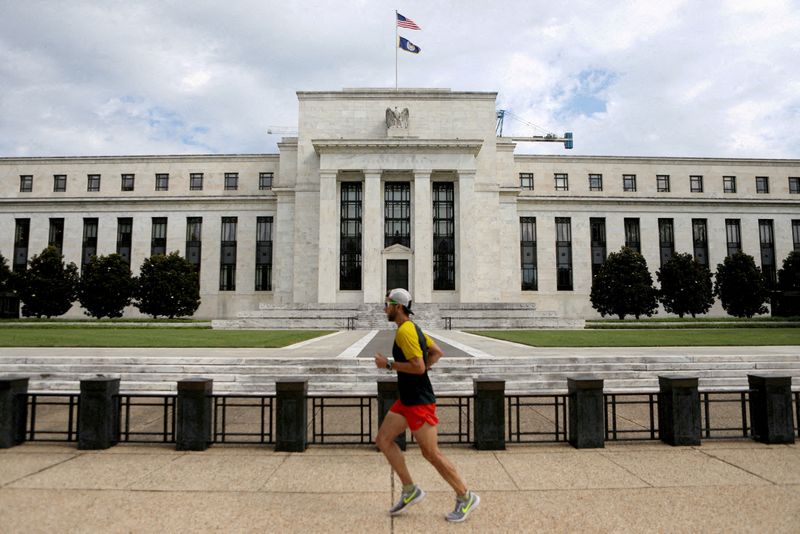By Howard Schneider
WASHINGTON (Reuters) -U.S. Federal Reserve concerns about a slowing job market were relieved for at least another month when new data on Friday showed job growth jumped and the unemployment rate fell in September, adding to investor bets the central bank will cut its benchmark rate only a quarter of a percentage point next month.
In comments this week Fed Chair Jerome Powell had noted the "tension" between steady economic growth and a perceived weakening of the job market, and said it was likely jobs data would prove a better gauge of where the economy stood.
On that front September's data buttressed the views of policymakers who feel the current economic expansion has momentum, and the unemployment rate, now 4.1%, able to remain around what many Fed policymakers consider to be full employment.
Indeed the numbers may have been too good, with headline job growth surging 254,000, a level most policymakers would consider unsustainable without adding to inflation pressure, and wage growth rising back to 4%, also above what's considered consistent with the central bank's 2% inflation target.
In light of the September jobs report, "the real debate at the Fed should be about whether to loosen monetary policy at all," said Capital Economics Chief North America Economist Paul Ashworth. "Any hopes of a 50 bp cut (in November) are long gone."
Chicago Fed President Austan Goolsbee, among those who have expressed deeper concern about the job market, called the report “superb” but said one such outcome doesn’t on its own change the Fed’s move to loosen monetary policy over coming months.
“We need to take the longer arc...If we get more reports like this we should have more confidence that we are settling at the landing spot we can,” Goolsbee said on Bloomberg Television, adding that the Fed has “both time and runway to figure out where the settling point is” for interest rates.
The Fed cut its benchmark rate by half a point in September, launching an anticipated series of rate reductions expected to continue at the Nov. 6-7 meeting.
But how fast and far the rate cutting proceeds from there will be determined by future jobs reports and whether inflation continues falling towards the Fed's targeted level. The Personal Consumption Expenditures price index targeted by the Fed showed inflation at 2.2% as of August, but a measure of the underlying inflation trend was higher at 2.7%, with some officials concerned it will decline only slowly for the rest of this year.
Traders took the jobs data as a signal the Fed may not be able to cut as deeply as expected, potentially stopping next year with the benchmark rate still above 3%, shy of the 2.9% Fed policymakers at the median consider to represent "neutral" monetary policy.
The rate is currently set in a range between 4.75% and 5.00%.
In a Reuters interview earlier this week Richmond Fed President Thomas Barkin raised that possibility as well, and said he felt there was some chance the job market would not only survive the Fed's period of tight monetary policy but might begin to tighten again - though he said he regarded that as a risk for next year.
"Employers running lean could well find themselves short" of workers and need to hire if demand in the economy holds up and growth continues, Barkin said. "As we decide how fast to move and how far to go during this rate-reduction cycle, we are just going to need to be attentive and learn as we go."
The September jobs report appears for now to leave intact the "base case" reflected in the Fed's most recent economic projections, and reaffirmed by Powell this week, of quarter-point rate cuts at the Fed's two remaining meetings this year, in November and December.
It may also reshape the sense of what risks the economy faces right now. Between slowing job growth, slowed hiring, and slowing wage growth, Fed officials in their September projections said risks had become skewed toward higher-than-expected unemployment.
Not only did job growth rebound in September, upward revisions to July and August data pulled three-month average payroll growth back to the trend seen in the decade before the pandemic, all but erasing a sharp dip lower.
In a Reuters interview this week Atlanta Fed President Raphael Bostic said he'd be watching coming employment reports to see if monthly payroll growth fell much below 100,000, the approximate level he feels is needed to absorb new entrants to the job market.
The September report blew past that level and past the expectations of most economists.
Bostic also said he'd be watching to see if job gains had narrowed to one or two industries.

For September at least, it didn't, with hiring across industries.
Given the Fed had moved interest rates to a quarter-century high to lower inflation, "the Fed has room to continue to cut, although moderately I suspect," said U.S. Bank Chief Economist Beth Ann Bovino. A quarter point cut in November "seems to be still in the pipeline, but the Fed could very well take a break after that and just gauge how the economy is moving along...This economy still looks pretty warm."